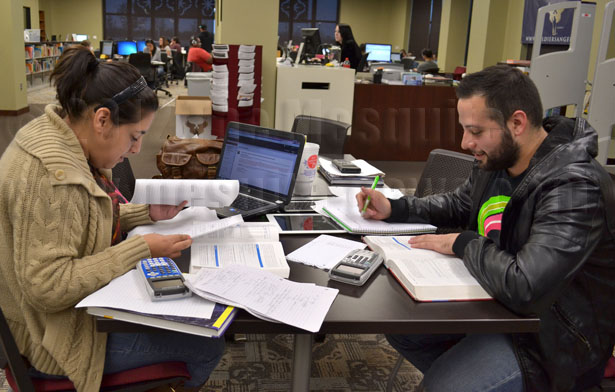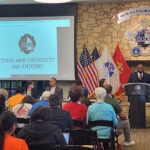
By Jacob Beltran
Students, faculty and staff attending Texas A&M-San Antonio’s Main Campus Building can use the Internet at 1 gigabyte per second thanks to fiber optic cables that connect the campus to a broadband network.
District 3 Councilwoman Leticia Ozuna said for the university, more speed means more connectivity and opportunity to access information needed to grow.
“Other universities that are using this are seeing rewards in the research faculty that they are attracting,” she said.
The cables were set in the ground before Main Campus was built in 2011, but did not go live until October, as announced during a press conference Oct. 30 at Main Campus.
Rodney Zent, executive director of education broadcast services at Texas A&M-College Station, said the university is so new, it has been able to leapfrog over much of the old technology, such as copper wiring used to connect to the Internet. He also said in many ways, the university is ahead of other institutions.
Ravindra Kallianpur, director of information technology services, said in a phone interview that although the cables are in the ground, the electronics that power them can be upgraded to allow speeds up to 40 gigabytes per second.
“Technology is a very dynamic thing,” Kallianpur said. “As a service group, we have to provide students faculty and staff with what they need.”
Rick Trefzer, assistant vice president for finance and administration, said during a phone interview that A&M-San Antonio is able to accommodate the growth in Internet usage that comes as the campus expands and gains more students.
“Tech in classrooms will probably consume more bandwidth.” Trefzer said, “It gives us the bandwidth and scalability to grow with the needs of the campus.”
Trefzer and Kallianpur were recognized for their efforts in collaborating with other campuses and were presented a commemorative plaque during the conference by The Texas A&M System for its participation in the Broadband Technology Opportunities Program.
“The plaque was for the campus’ participation in the grant, so there were a couple of us that served as liaisons locally to help keep the project on track,” Trefzer said. “This project was handled for the most part out of College Station.”
Zent made a comparison between the fiber optic and University Way, the mile-long road that leads to Main Campus Building.
He said although the road seems like “overkill” leading up to one building, it will someday support a large campus just like the fiber optic will.
“The leadership of this campus has embraced those rapidly changing lifestyles and students who want immediate answers through iPhones, iPads (and) laptops,” he said.
Funding the need for speed
To fund the project, a Broadband Technology Opportunity Program grant written by Dr. Walt Magnussen, director of telecommunications for Texas A&M-College Station, was designed to tie the A&M campuses together with a high speed network.
The Trans Texas Video Network, a centralized department in College Station, which provides telecommunications services to the 11 campuses, was awarded $6.5 million in federal funds from the Broadband Technology Opportunity Program grant. One and a half million dollars was donated to the project from the network itself.
Finally, another $1.5 million came from the private public partnership between Texas A&M-College Station and Valley Telephone Cooperative Inc. (VTX) a cooperative company that provides broadband access to rural areas.
Trefzer said that thanks to the collaboration, the cost to wire the campus with fiber optic cable was not as expensive than if A&M-San Antonio had decided to purchase the equipment on its own.
“We were able to make this major construction at today’s prices instead of waiting until the need was there which would have meant higher prices,” Trefzer said. “It may not have been possible if it was the sole responsibility of the San Antonio campus.”
Fiber optic now, less work later
Marcus Ramirez, network manager for VTX, said during a phone interview that the farther away a customer is from an Internet access headquarters, the more expensive and slower the Internet speed.
The same goes for copper wiring, which is still used by most of San Antonio to provide Internet services by companies such as AT&T.
Copper wiring can support at the most 80 megabytes per second, something that telephone companies such as AT&T are pushing by using more powerful electronics to transfer data.
Ramirez said that because AT&T uses copper wiring, they’re taking their time to upgrade the electronics to keep up with other companies, otherwise the cost to replace all the copper wiring at once with fiber optic would be far too expensive for the company to handle.
“Fiber is pretty much limitless,” Ramirez said, “There are electronics that can do 100 gigabytes.”
Ramirez said the cost of electronics used to transfer data across fiber optic cable can range from about $20,000 to “hundreds of thousands of dollars.”
Ozuna acknowledged at the press conference that Broadband Technology Opportunity Program funding is a key part in building out the University and filling out its infrastructure.
Public access to broadband network
To bring broadband access to the general public, Ozuna has written her own proposal called the San Antonio Area Broadband Network, which will “build a collaborative effort between the city and other governmental entities to expand fiber capability in San Antonio.”
Deanne Cuellar, chief information officer for Ozuna’s District 3 office, said, “The law is clear that the city can not function as a service provider … so you could not approach the city and say I want the city of San Antonio to provide Internet access for me.”
The proposal cites section 54.202 of the Public Utility Regulatory Act, which states that municipalities are specifically forbidden from the public sale of “a non-switched telecommunications service used to connect a customer’s premises to another customer or a long distance provider.” Read more
Instead, the proposal suggests connecting government entities to improve the transfer of information between them while benefiting the public as well.
“Those that qualify are … public parks, police departments and universities,” Cuellar said, “so you could do something as glamorous as high speed Internet in a park or access for students at A&M university.”
According to the proposal, any connections made to the broadband network require the approval of a joint operations committee prior to deployment, because of a memorandum of understanding between the city and CPS energy.
The memorandum states that connections to the network must be made for city or CPS Energy business-related reasons.
By using a fiber optic network to communicate amongst governmental entities, each government entity will pay for its own usage, a price that may increase as more groups join the operation.
The proposal states that universities and other governmental entities that join SAABN will receive tremendous technological and other benefits from their participation.
Cuellar said agreements can be made between the city and a university such as allowing employees to attend the university.
In return, operational costs to maintain broadband access would be lowered for the university.
“A university would be interested in that because they’re dependant on their research and students need Internet access to complete their curriculum,” she said. “They pay a much bigger fee now then they would as part of a municipal network.”
During the press conference, Ozuna said access to “big pipes” isn’t a commodity but a necessity for infrastructure.
“It’s about a road being built for everyone,” she said.






